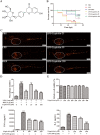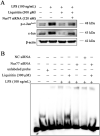Liquiritin exhibits anti-acute lung injury activities through suppressing the JNK/Nur77/c-Jun pathway
- PMID: 37013552
- PMCID: PMC10068703
- DOI: 10.1186/s13020-023-00739-3
Liquiritin exhibits anti-acute lung injury activities through suppressing the JNK/Nur77/c-Jun pathway
Abstract
Background: Licorice (Glycyrrhiza uralensis Fisch.), a well-known traditional medicine, is traditionally used for the treatment of respiratory disorders, such as cough, sore throat, asthma and bronchitis. We aim to investigate the effects of liquiritin (LQ), the main bioactive compound in licorice against acute lung injury (ALI) and explore the potential mechanism.
Methods: Lipopolysaccharide (LPS) was used to induce inflammation in RAW264.7 cells and zebrafish. Intratracheal instillation of 3 mg/kg of LPS was used for induction an ALI mice model. The concentrations of IL-6 and TNF-α were tested using the enzyme linked immunosorbent assay. Western blot analysis was used to detect the expression of JNK/Nur77/c-Jun related proteins. Protein levels in bronchoalveolar lavage fluid (BALF) was measured by BCA protein assay. The effect of JNK on Nur77 transcriptional activity was determined by luciferase reporter assay, while electrophoretic mobility shift assay was used to examine the c-Jun DNA binding activity.
Results: LQ has significant anti-inflammatory effects in zebrafish and RAW264.7 cells. LQ inhibited the expression levels of p-JNK (Thr183/Tyr185), p-Nur77 (Ser351) and p-c-Jun (Ser63), while elevated the Nur77 expression level. Inhibition of JNK by a specific inhibitor or small interfering RNA enhanced the regulatory effect of LQ on Nur77/c-Jun, while JNK agonist abrogated LQ-mediated effects. Moreover, Nur77-luciferase reporter activity was suppressed after JNK overexpression. The effects of LQ on the expression level of c-Jun and the binding activity of c-Jun with DNA were attenuated after Nur77 siRNA treatment. LQ significantly ameliorated LPS-induced ALI with the reduction of lung water content and BALF protein content, the downregulation of TNF-α and IL-6 levels in lung BALF and the suppression of JNK/Nur77/c-Jun signaling, which can be reversed by a specific JNK agonist.
Conclusion: Our results indicated that LQ exerts significant protective effects against LPS-induced inflammation both in vivo and in vitro via suppressing the activation of JNK, and consequently inhibiting the Nur77/c-Jun signaling pathway. Our study suggests that LQ may be a potential therapeutic candidate for ALI and inflammatory disorders.
Keywords: Acute lung injury; JNK; Lipopolysaccharide; Liquiritin; Nur77; c-Jun.
© 2023. The Author(s).
Conflict of interest statement
The authors declare that they have no competing interests.
Figures







Similar articles
-
Emodin Protects Against Lipopolysaccharide-Induced Acute Lung Injury via the JNK/Nur77/c-Jun Signaling Pathway.Front Pharmacol. 2022 Mar 17;13:717271. doi: 10.3389/fphar.2022.717271. eCollection 2022. Front Pharmacol. 2022. PMID: 35370650 Free PMC article.
-
Liang-Ge-San, a classic traditional Chinese medicine formula, attenuates acute inflammation in zebrafish and RAW 264.7 cells.J Ethnopharmacol. 2020 Mar 1;249:112427. doi: 10.1016/j.jep.2019.112427. Epub 2019 Nov 25. J Ethnopharmacol. 2020. PMID: 31778782
-
Inhibition Of JNK Phosphorylation By Curcumin Analog C66 Protects LPS-Induced Acute Lung Injury.Drug Des Devel Ther. 2019 Dec 10;13:4161-4171. doi: 10.2147/DDDT.S215712. eCollection 2019. Drug Des Devel Ther. 2019. PMID: 31849448 Free PMC article.
-
Sichen Formula Ameliorates Lipopolysaccharide-Induced Acute Lung Injury via Blocking the TLR4 Signaling Pathways.Drug Des Devel Ther. 2023 Feb 2;17:297-312. doi: 10.2147/DDDT.S372981. eCollection 2023. Drug Des Devel Ther. 2023. PMID: 36756190 Free PMC article.
-
23-O-acetylshengmanol-3-O-α-L-arabinoside alleviates lipopolysaccharide-induced acute lung injury through inhibiting IκB/NF-κB and MAPK/AP-1 signaling pathways.J Ethnopharmacol. 2023 Jan 10;300:115725. doi: 10.1016/j.jep.2022.115725. Epub 2022 Sep 14. J Ethnopharmacol. 2023. PMID: 36115602
Cited by
-
Self-Assembled Nanoparticles from Xie-Bai-San Decoction: Isolation, Characterization and Enhancing Oral Bioavailability.Int J Nanomedicine. 2024 Apr 8;19:3405-3421. doi: 10.2147/IJN.S449268. eCollection 2024. Int J Nanomedicine. 2024. PMID: 38617795 Free PMC article.
-
Qimai Feiluoping Decoction Inhibits EndMT to Alleviate Pulmonary Fibrosis by Reducing PI3K/AKT/mTOR Pathway-Mediated the Restoration of Autophagy.J Inflamm Res. 2025 Jun 26;18:8447-8475. doi: 10.2147/JIR.S515286. eCollection 2025. J Inflamm Res. 2025. PMID: 40589610 Free PMC article.
-
Dang-Gui-Si-Ni decoction facilitates wound healing in diabetic foot ulcers by regulating expression of AGEs/RAGE/TGF-β/Smad2/3.Arch Dermatol Res. 2024 Jun 7;316(7):338. doi: 10.1007/s00403-024-03021-0. Arch Dermatol Res. 2024. PMID: 38847916
-
Clinical application, potential pharmacological targets and quality marker prediction of a TCM formulation used (Shenling Baizhu San) in the treatment of respiratory diseases.Front Pharmacol. 2025 May 29;16:1575903. doi: 10.3389/fphar.2025.1575903. eCollection 2025. Front Pharmacol. 2025. PMID: 40510424 Free PMC article. Review.
-
Regulated programmed cell death in acute lung injury: from pathogenesis to therapy.Front Immunol. 2025 Jul 23;16:1630015. doi: 10.3389/fimmu.2025.1630015. eCollection 2025. Front Immunol. 2025. PMID: 40771815 Free PMC article. Review.
References
Grants and funding
LinkOut - more resources
Full Text Sources
Research Materials
Miscellaneous

